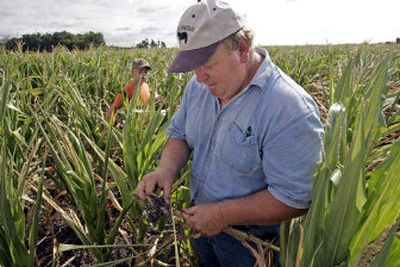Illinois is ground zero of Farm Belt’s drought

PUTNAM, Ill. – A thin cornstalk comes out of the dry, dusty ground with just a slight tug, its bug-eaten roots barely an inch long. Husks peel back to reveal scraggly-looking ears not much longer than a thumb.
Jonathan Downey’s crop is suffering, the victim of a drought that is stunting crops across the Farm Belt but is especially severe in Illinois.
Illinois is going through its worst dry spell in nearly 20 years. And because the state accounted for nearly one-fifth of the nation’s corn crop last year, the market is watching closely.
Other Corn Belt states are in better shape. But Illinois grew 2.1 billion bushels of corn in 2004, second only to Iowa, and its soybean harvest of just under 500 million bushels was the nation’s biggest.
“That’s why there’s a great deal of attention being paid to Illinois,” said Joe Victor, vice president of marketing for the commodity research firm Allendale Inc. “We do matter. It is a concern.”
Nearly half the state is classified by the U.S. Agriculture Department as being in extreme drought.
With at least 74,000 of the state’s farmers estimating crop losses of 30 percent or more, Agriculture Secretary Mike Johanns said Wednesday he would sign a disaster declaration for nearly all of Illinois’ 102 counties.
Even so, the effect on commodities prices and the price of corn at the grocery store is expected to be modest because the worst of the drought is pretty much confined to Illinois, said Dale Gustafson, a grain market analyst for Smith Barney in Chicago.
While 56 percent of Illinois’ corn crop is rated in very poor or poor condition, only 10 percent of Iowa’s crop is poor or worse and 19 percent of Indiana’s crop is rated that way.
“It’s devastating for the Illinois producers who are in it, but on a national basis this does not compare to the (drought) of 1988 which was over a much, much greater area,” said Gustafson, who figures the state’s corn crop could be about 25 percent smaller than it was last year.
Illinois has received only about 8.5 inches of rain from March through June, about half the normal amount, according to state officials.
Monty Whipple, who farms 700 acres near Utica, said that while recent rain has helped his corn perk up a bit, he will be lucky to get half the harvest he had a year ago.
“Last year was a great year. It might have been my best ever,” he said. “And now this year might be one of my worst.”
He grabbed a white stub only about as long as his thumb – an ear of corn that by now should be almost a foot long and full of plump buttery yellow kernels. This ear had only a few tiny kernels.
“There’s all kinds of ears like that. That ear’s not going to get much bigger and then it’s going to shrivel down and you’ll end up with a little nubbin,” he said.
“It won’t even get in the combine. It’s going to be too small.”
Crop insurance will help protect farmers like Downey and Whipple, but higher prices for fertilizer, seed, rent and fuel this year have already cut their profit margins. A smaller crop will probably mean lower income, even if corn prices rise.
Soybeans also are suffering, but they develop later and still could yield a good crop, if there is enough rain in August. Even so, the crop will be smaller than last year’s, dealing another blow to the farm economy.
“You do everything you can and then after awhile it’s not in your hands,” Whipple said.